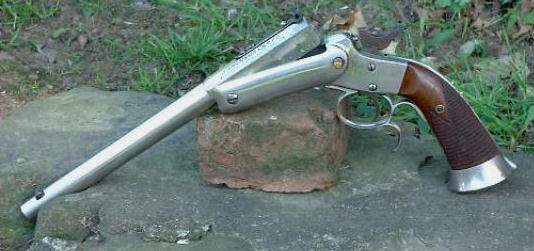

 The Accurate Reloading Forums
The Accurate Reloading Forums  THE ACCURATE RELOADING.COM FORUMS
THE ACCURATE RELOADING.COM FORUMS  Guns, Politics, Gunsmithing & Reloading
Guns, Politics, Gunsmithing & Reloading  Single Shot Pistols
Single Shot Pistols  Is the 30-30 a Contender Frame Stretcher?
Is the 30-30 a Contender Frame Stretcher?Go  | New  | Find  | Notify  | Tools  | Reply  |  |
| one of us |
I recently purchased a used 16" 30-30 carbine barrel for my Contender. It seems like backthrust and possibly pressure would be a problem and that this cartridge could be a "frame stretcher".... What say you? Should I keep my loads on the light side? I bought this barrel strictly for hunting. $bob$ | ||
|
one of us |
LDHunter I don't think it is a frame stretcher unless you over do it. I'm sure other who have better understanding of this cartridge will jump in. The only thing that you may find, is that it may not perform to your expectations. If that is the case there are a number of ways to go with that. Plenty of options as far as rechambering goes. Who knows you may just find it is exactly what you are looking for. Rich Jake | |||
|
| one of us |
Bob, you could stretch your frame with it, but really doubt it. I have been shooting with a fellow that uses the grand ole thuty-thuty, he is crowding the lower end of some .308 WW loads. He likes speed and the recoil he has under control. He has shot 1000's of rounds through his first 30-30 factory barrel, and I never once heard him say anything about frame stretch or bad performance. BTW he likes the ease of reloading the 30-30 so much he had BB make him a new one with a match chamber. I am not here to talk up the 30-30 but this round did catch a lot of bad press a few years back and it still does to some extent today. There is not a thing wrong with this round in a 10"-16" barrels, I would be perfectly happy with a 30-30 and factory loads. But on the reloads you can make a FINE shooter out of most barrels with a little TLC. Jeff | |||
|
| one of us |
Fact is, for about the last nearly 10 years, TC has had NO throat in the .30/30 barrels. It is possible they may have finally felt the heat and gone back to the previous chamber design that had an actual throat in it. For years they used reamers that cut about a .050" overly long neck and only a chamfer on the ends of the rifling. I have an article on my site in regard to what a throat actually is. Look in the articles section: www.bellmtcs.com Simply running a PROPER throat reamer in that is very close to bullet diameter, and with the barrel's bore dialed in true of course, you can cut groups roughly in half or better. Don Shearer did extensive work with such a barrel with very positive results after rethroating. I technically should not call it "rethroating" since the barrels do not have a throat to begin with. And I have to agree, properly chambered and properly loaded for, the .30/30 is an excellent Contender round that is only perhaps a little less friendly to the frame than some other rounds, but only if you load it to the gills. One good indication with most rounds is hard opening of the barrel. It is an indication the case has set back hard against the frame. That is why it is hard to open. So long as you don't shoot at that level routinely, it is as safe to the frame's health and well-being as any. You just can't make it do what you can with thicker, stronger brass in a straight walled chamber. Guy Malmborg in Salt Lake City will throat these for you. Email is diveboss@xmission.com or call him at (801) 943-8563. Tell him I referred you. Extending the throat by about .175" in the chambers with no throat is about optimum and makes a world of difference. Once throated, seat your bullets out as far as practical, but not hard into the rifling where you create a round that is too long for the chamber. Neither the case shoulder or the bullet seated into the rifling should leave the case heads sticking out of the barrel more than what the actual barrel to frame gap is, preferrably about .001" less than the gap. Ie., use the barrel's chamber as your "guage" to determine seating depth as well as size die adjustment. You don't need to buy a guage or other gizmo.... your barrel is the guage. Mike | |||
|
| Powered by Social Strata |
| Please Wait. Your request is being processed... |
|
 The Accurate Reloading Forums
The Accurate Reloading Forums  THE ACCURATE RELOADING.COM FORUMS
THE ACCURATE RELOADING.COM FORUMS  Guns, Politics, Gunsmithing & Reloading
Guns, Politics, Gunsmithing & Reloading  Single Shot Pistols
Single Shot Pistols  Is the 30-30 a Contender Frame Stretcher?
Is the 30-30 a Contender Frame Stretcher?

Visit our on-line store for AR Memorabilia

